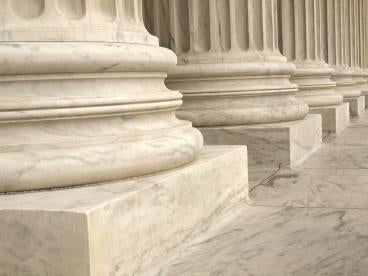In Mahoney v. U.S. Department of the Interior,[1] the United States District Court for the Eastern District of New York recently addressed an environmental challenge to the South Fork Wind Farm (“Wind Farm”) that is being constructed on the Outer Continental Shelf (“OCS”) approximately 35 miles off Montauk Point, New York. The Mahoney decision is illustrative of the “shore side” legal challenges faced by the offshore wind industry and is a reminder of the continued significance of constitutional standing doctrine, which requires parties bringing suit to demonstrate that they are appropriate parties to bring an environmental challenge to court.
Factual Background
Plaintiffs, residents of East Hampton, New York, brought an action to halt the construction of the Wind Farm and the Wind Farm’s Export Cable Project (“Export Cables”). The Export Cables Project required onshoring trenching to tie the cables carrying power offshore into the shore-side power grid. As the proposed trenching location was adjacent to their property, the Plaintiffs were concerned that the Export Cable trenching would worsen pre-existing perfluoroalkyl and polyfluoroalkyl (“PFAS”) groundwater contamination in their groundwater. Plaintiffs challenged permits issued by Bureau of Ocean Energy Management (“BOEM”), and the U.S. Department of the Army, and U.S. Army Corps of Engineers (the “Army Corps”) for the Wind Farm and the Final Environmental Impact Statement (“FEIS”) issued in connection with the permits.
The District Court’s Decision
Plaintiffs suit was based on the assertion that the Wind Farm’s permits and FEIS did not adequately consider the potential of PFAS contamination as required under the National Environmental Policy Act (“NEPA”), Clean Water Act (“CWA”), Outer Continental Shelf Lands Act (“OCSLA”) and the Administrative Procedure Act (“APA”). The Government moved to dismiss suit under the constitutional standing doctrine.
Under Article III of the Constitution, federal courts can only hear disputes if the plaintiff has standing to sue.[2] “[T]o establish standing, a plaintiff must show (i) that he suffered an injury in fact that is concrete, particularized, and actual or imminent; (ii) that the injury was likely caused by the defendant; and (iii) that the injury would likely be redressed by judicial relief.”[3] A plaintiff has the burden to establish each element of the standing test.[4]
The Court’s analyses focused on the second element – whether the Plaintiffs established a causal connection between the federal agencies decision to permit the Wind Farm and Plaintiffs’ alleged damages, which the loss of Plaintiffs’ property value due potential PFAS contamination. Plaintiffs alleged that the causation element was met because “but for” the federal agencies requiring the wind farm developer to use the route for the Export Cables specified in the permits, Plaintiffs would not sustain any property damage.
The District Court noted that the location and manner of onshore trenching for the Export Cables were dictated by local and state agencies, which included the New York State Power Commission (“NYSPC”), which approved the trenching after a lengthy administrative process in which Plaintiffs participated. The NYSPC rejected Plaintiffs’ argument that the Project would exacerbate the existing PFAS contamination in their groundwater, given the preventative measures employed by the Project to ensure groundwater flow was not altered. By contrast, the federal agency defendants did not require or specify the location of the onshore trenching of the Export Cables in connection with their approvals, leaving these details to NYSPC and its administrative process. The District Court rejected Plaintiffs’ contention as too attenuated that “but for” the federal agencies permitting the Wind Farm as a whole, there would not be any need for the Export Cables.
Under the relevant federal statutes, the District Court held that BOEM had jurisdiction over the portion of the Wind Farm on the OCS under the OCSLA and the Army Corps had jurisdiction over permits needed to discharge dredged waste matter under the CWA. The District Court held that Plaintiffs’ alleged injuries were directly traceable to NYPSC, which had exclusive jurisdiction over onshore trenching and whose third-party actions were not before the Court. Accordingly, the District Court dismissed the suit due to lack of standing.
Conclusion
The decision in Mahoney v. U.S. Department of the Interior is a reminder the standing doctrine remains a formidable hurdle to those asserting an environmental challenge. The decision is a further reminder of the complex web of state and federal action that is required to bring offshore wind energy into the shoreside power grind.
[1] See Mahoney v. U.S. Department of The Interior, No. 22-CV-1395, 2023 WL 4564912 (E.D.N.Y. July 17,2023).
[2] Raines v. Byrd, 521 U.S. 811, 818, 117 S.Ct. 2312, 138 L.Ed.2d 849 (1997).
[3] TransUnion LLC v. Ramirez, ––– U.S. ––––, 141 S. Ct. 2190, 2203, 210 L.Ed.2d 568 (2021) (citing Lujan v. Defenders of Wildlife, 504 U.S. 555, 560-61, 112 S.Ct. 2130, 119 L.Ed.2d 351 (1992)).
[4] Spokeo, Inc. v. Robins, 578 U.S. 330, 338, 136 S.Ct. 1540, 194 L.Ed.2d 635 (2016).




 i
i


